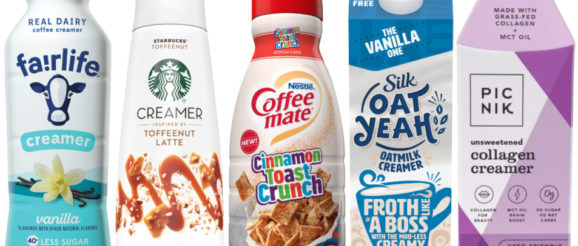Slideshow: Coffee creamer innovation on the upswing

Millennials are both avid consumers and judicious shoppers when it comes to coffee creamers, according to Packaged Facts. They are significantly more likely than average to use commercial packaged creamers, non-dairy cream substitutes, dairy beverages and plant-based dairy alternatives in their coffee.
Additionally, product innovation in liquid creamers through the introduction of new flavors has boosted popularity among younger coffee consumers, according to IBIS World, New York. The market research firm projects the creamer category to continue its healthy growth trajectory as coffee and tea consumption increases. Strong growth is expected from non-dairy concepts, reflective of the number of consumers who are reducing dairy and animal-based products from their diet,
Most innovation has been in the liquid refrigerated space, but there’s also been noteworthy activity in shelf-stable liquid, namely in portion packs for food service as well as powdered mixes. This includes both dairy and non-dairy formulations.
The popularity of the keto diet has been a significant contributor to the popularity of creamer. The keto diet is approximately 70% fat, 20% protein, and 5% each simple carbohydrates and non-starchy vegetables. By eating a lot of fat and few carbohydrates, the body is forced into a metabolic state known as ketosis. This is when the body burns fat instead of carbohydrates for energy. The liver converts fat into fatty acids and ketone bodies, with the latter traveling to the brain and fueling the body, the traditional role of glucose obtained from carbohydrates. Burning ketones in place of glucose is associated with weight loss, reduced inflammation, sustained energy and more.
Value-added creamers designed specifically for keto dieters may include medium chain triglyceride fats. These are inherently concentrated in milkfat and coconut oil and are recognized for assisting the body with breaking down fat.
Dairies, coffee companies, beverage manufacturers and start-ups are exploring opportunities in the creamer category. Austin, Texas-based Picnik, for example, a forerunner in the grass-fed butter coffee creamer category, has added vegan and non-dairy collagen varieties.
“I created Picnik after discovering the life-changing difference that high-quality fats and other functional ingredients could have on physical health and mental clarity,” said Naomi Seifter, founder and chief executive officer. “Based on the response we received to our original creamer, we knew we wanted to expand the line so it was more inclusive of all dietary needs.”
This past summer, Starbucks Corp., Seattle, and Nestle USA, Arlington, Va., brought the Starbucks brand to the refrigerated retail creamer category after forming an alliance in 2018. Since forming the alliance, both companies saw creamers as a growth opportunity. They decided to leverage Nestle’s expertise in the creamer category and Starbucks’ heritage and well-known coffee house flavors to bring Starbucks Creamers to the retail market.
“Nestle has been a leader in the creamer category since launching Coffee-mate in 1961 and we continue to innovate and help drive category growth,” said Daniel Jhung, president of beverage, Nestle USA. “In our work with Starbucks through our global coffee alliance, we saw the opportunity to introduce Starbucks Creamers as a new way for consumers to enjoy the Starbucks café flavors they know and love from the comforts of their home.”
